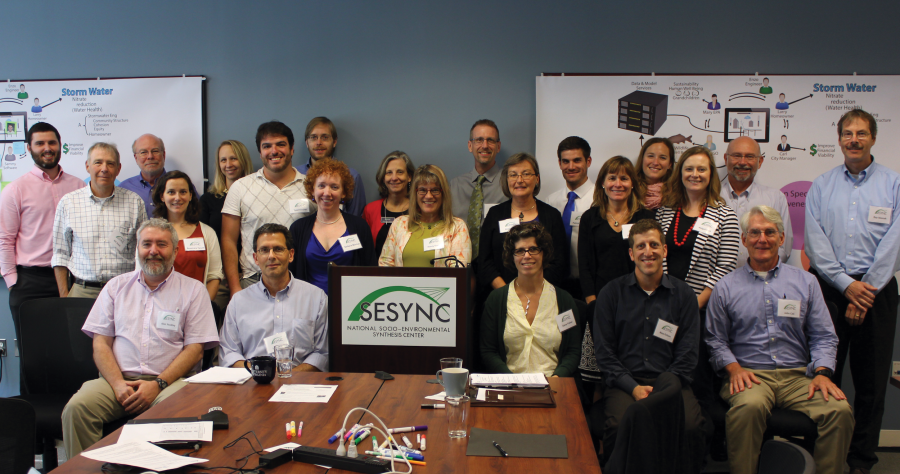
Imagine a scientific endeavor that takes place in a laboratory—but not one of those labs with white coats and silent concentration. In our laboratory, we replace white coats with white boards, flip charts, and a box of washable markers large enough to make any kindergartener giddy; replace silent concentration with three days of constant interaction that makes the room sound more like a tuning orchestra than a formulaic meeting.
This scene is not an unusual one at SESYNC, but a recent meeting of the Role of Green Infrastructure project brought together an especially diverse set of participants to tackle especially ambitious goals. The project’s overarching purpose is two-fold: to understand what role green infrastructure can play in improving stormwater management and ecosystem service delivery and, simultaneously, to test a process for engaging scientists in sustainable software development as they apply and develop tools to address these issues.
Our first task was to hone in on a shared idea of what is meant by “green infrastructure” and to envision where each of the 25 participants—including hydrologists, ecologists, city managers, governance scholars, software engineers, and nonprofit program directors—fit into the picture. Many of our supported science teams at SESYNC use the process of conceptual diagramming to facilitate the challenging work of integrating the wide range of transdisciplinary perspectives of their participants. It’s important for each participant to externalize (i.e., get on paper) their conception of the systems being discussed so that they can identify and discuss commonalities and differences in the approaches they bring to a problem. To kick off this activity, the principal investigators (PIs) discussed their shared conception, then each participant was asked to place a pre-printed picture of themselves on the diagram to indicate where they saw their research interest or professional role fitting into the diagram the PIs had crafted. Over lunch, participants used giant sticky notes and lots of markers to create their own individual conceptual frameworks of green infrastructure, which were then used in discussions throughout the course of the three-day meeting, and eventually distilled and integrated into a larger framework.
We heard from practitioners and managers from five cities around the country who each told their city’s story of stormwater management and the potential of green infrastructure to deliver that service and more. Although each local context is unique, they all need metrics (ultimately in dollars and cents) to show that green infrastructure works for stormwater management and other critical city services, and that it is thus worth the investment.
Each researcher then gave a short presentation on their current work and how it relates to green infrastructure. It turns out we do many things across the wide sustainability spectrum—from server-style data management to field infrastructure design, biophysical evaluation to institutional arrangements, and issues of equity to general access. It was exciting to watch experts from so many diverse areas come together to frame big issues around green infrastructure and develop a plan to tackle them. No matter how great our disciplinary differences may be, we all contribute to what a real green infrastructure conception is—one that we hope will inform our research questions, generate needed solutions, and push our understanding as scientists.
Through moments of frustration, exhaustion, and more and more questions, what we can say is that everyone is ready to work together on a shared venture towards solution-focused green infrastructure research.
This Venture seeks in part to prototype a process conceived by the PIs as part of an NSF S2I2 conceptualization award for a Water Science Software Institute, which aims to address software development and sustainability needs of the water science community.
